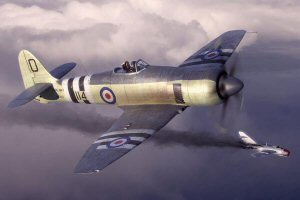
Hobbycraft 1/32 Sea Fury FB.11 Cold War Fighter Kit First Look
By Michael Benolkin
| Date of Review | October 2007 | Manufacturer | Hobbycraft |
|---|---|---|---|
| Subject | Hawker Sea Fury FB.11 | Scale | 1/32 |
| Kit Number | 1716 | Primary Media | Styrene |
| Pros | First injection-molded Sea Fury kits in this scale; simple construction | Cons | One piece canopy, nose ahead of windscreen is a little steep and faceted (see text) |
| Skill Level | Basic | MSRP (USD) | $39.95 |
First Look
 |
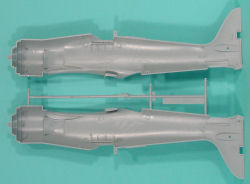 |
 |
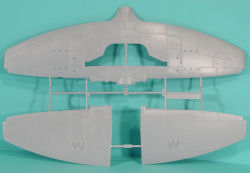 |
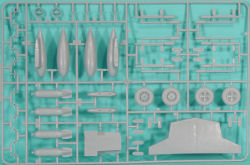 |
 |
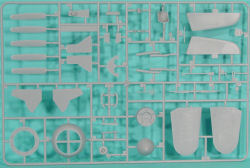 |
 |
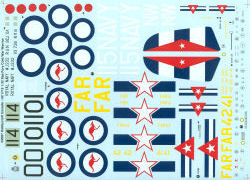 |
 |
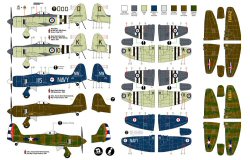 |
As the Fleet Air Arm was separated from the RAF, they sought their own fighter to be compatible with carrier operations. Current production designs were adapted into such as the Supermarine Seafire. While a capable fighter, the narrow landing gear was not ideal for arresting about a pitching and rolling carrier deck.
The Hawker Company had produced a wide array of hard-working and durable for the RAF prior to, and during the Second World War. One design under consideration was a lightweight fighter designated Fury. Hawker offered a navalized version that would become the Sea Fury. The aircraft was powered by the Centaurus radial engine rated at 2480 horsepower.
While the Sea Fury entered service too late for World War II, it did see combat over Korea as well as conducting operations in the Suez crisis. While the Sea Fury would be the Royal Navy's last piston fighter, the Sea Fury would soldier on in a variety of international air forces and can still be found at airshows or as one of the most popular air racers.
Hobbycraft Canada just sent us a preview of their upcoming 1/32 Sea Fury FB.11 kit and overall, the kit isn't bad! The kit is molded in gray styrene and presented on four parts trees, plus a single clear part representing the windscreen/canopy. I've provided extra images of the fuselage interiors and the flip-side of the parts tree with the cockpit tub and main wheel well.
At first blush, the kit is laid out nicely and doesn't appear to have any tricky spots that will impede construction or require any special skills. The fuselage halves fit snugly together so the need for seamline filler will be little to none.
The first thing that caught my eye was the windscreen and canopy. This part is a single piece, you cannot pose the canopy open. This might be okay in 1/72 scale, but in larger scales, especially 1/32, this is not. The only solution options here is to build the cockpit stock (it is simple) and leave the canopy closed, carefully cut the windscreen from the canopy (not my favorite option in this case), or use the kit part as a master to create a vacuformed canopy that will be much easier to separate from the windscreen. I suspect there will be some aftermarket options coming.
Of course I pulled out my Fisher Models 1/32 Sea Fury kit and looked at the silhouettes/shape of the fuselage and wings. The wings match up nicely with one another, right down to the cutouts for the main wheel wells.
The fuselage matches up in length and at the checkpoints - wingroot, rudder line, cowling edge, and instrument panel comb. Two things that did show up are:
1. The opening of the Hobbycraft cockpit appears too short compared to the Fisher fuselage. Once you see it, it looks too short and would be heck to climb into in full scale. This is easily fixed - carefully remove the headrest/rollover pylon, cut the opening aft about a quarter of an inch, then reinstall the pylon in its new position.
2. The second thing is a little more interesting - it looks like the aircraft contracted Sparviero nose. The slope from the windscreen to the cowling is a little too steep and what's more, the surfaces from the left and right quarter panels to the cowling. There are two flat facets up front. The real aircraft (and the 1/48 Hobbycraft kit) is round over the top of that nose.
Is this a big problem? Nope. The facets are easily rounded with a sanding stick and carefully scribe the panel lines back into place. In all, this shouldn't take more than 30 minutes worth of tweaking and sanding. I just may leave that slope alone since it really isn't that bad...
The main wheel wells are a bit Spartan as well, so plan on adding some wire and some small parts out of your spares to busy up this area.
There is a good chance that Fisher Models will be releasing a cockpit and wheel well set for this kit. Keep tuned for more details.
The kit comes with a nice array of external stores including drop tanks, bombs, and rockets.
Two large sheets of decals are provided for this kit to render one of five examples:
- FB.11 WJ232, 802 Sqn, Royal Navy, O/114, HMS Ocean, Korea, Aug 1951
- FB.11, VX726, 802 Sqn, RAN, K/101, HMAS Sydney, Japan, 1952
- FB.11, WH589, RAN, NW/115, RAN Bankstown, 1968
- FB.11, 42, FAR (Cuban Air Force), Bay of Pigs Invasion, 1961
- FB.11, 41, FAR, Post Invation, 1961
So how does this look? As I said in the beginning, it is not bad, even considering the nose. When you consider that this is a new-tool 1/32 kit with an MSRP of only $39.95, then you have quite a bit of potential here.
If you're a modeler, you too can take this kit and tweak it yourself as this has lots of potential. Once the aftermarket community jumps on this bandwagon, you'll have some very attractive options. How about a nice color photo-etch set for the cockpit Eduard? Please?
My sincere thanks to Hobbycraft Canada for this review sample!







